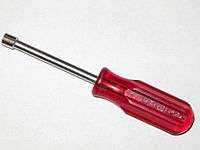Nut driver
A nut driver is a tool for tightening nuts and bolts. It essentially consists of a socket attached to a shaft and cylindrical handle and is similar in appearance and use to a screwdriver.[1] They generally have a hollow shaft to accommodate a shank onto which a nut is threaded. They are typically used for lower torque applications than wrenches or ratchets and are frequently used in the appliance repair[1] and electronics industries.[2]
Variations include T-shaped handles for providing the operator with a better grip, ratcheting handles, sockets with recessed magnets for holding fasteners, and flex shafts for bending around obstructions.
A spinner handle is a shaft and handle with a drive fitting—most commonly ¼"—at the end for attaching interchangeable sockets. This allows one to use a single handle with a number of sizes instead of having a separate nut driver for each size. However, a spinner lacks the benefit of a hollow shaft; thus, a common alternative system is a single handle with interchangeable shafts in each size.
See also
References
- Eugene Silberstein (12 May 2011). Residential Construction Academy HVAC. Cengage Learning. pp. 115–. ISBN 978-1-285-22526-5.
- Gerry Herrick (January 1992). Electronic assembly: soft soldering and wire wrapping. Prentice Hall. ISBN 978-0-13-248766-5.

